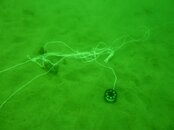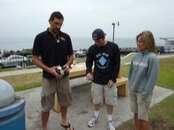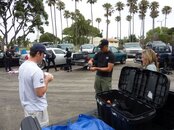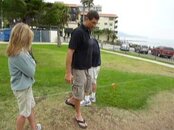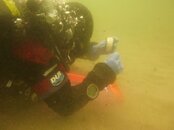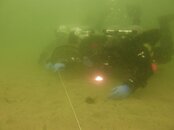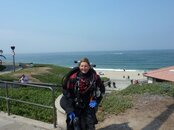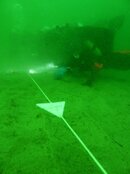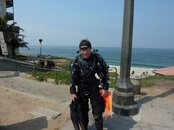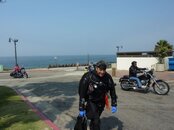Blackwood
Contributor
Friday, August 14. 9:00a. Veterans Park, Redondo Beach CA, three friends/dive buddies meet up to begin what would become an eventful, eye-opening, humbling, and educational weekend.
We all have varied backgrounds, but compatible training (albeit with dramatically differing experience levels) and dive philosophies.
The students:
Andy - advanced trimix diver, full cave diver and UTD technical instructor,
Kim - advanced trimix diver, and
Marc - technical diver.
The instructor:
Andrew, Unified Team Diving founder and Training Director.
For those who are unfamiliar with the UTD curriculum, it was decided that there are enough similarities between Wreck and Cave diving to merit an introductory course in those cross-environment protocols and (more importantly) thought processes. The result: Overhead Protocols. A student can then go on to environment-specific assessment and experience dives. In our case, we are moving towards Wreck 1 in October, but a student will be equally prepared for Cave 1.
The UTD philosophy for an overhead environment calls progressive penetration (environmental navigation), but stresses that when the fit hits the shan (or more appropriately the sin hits the filt), the only reliable way home is along a continuous guideline to the exit. Accordingly, core skills revolved around line work, including running and retrieving line, navigating line blind, lost line retrieval and broken line repair. Further taught were lost buddy procedures, rescue procedures and gas management.
All skills were demonstrated and practiced during two 2-3 hour dry land lecture sessions. Because the in-water portion of the course is completed in a non-overhead environment, we covered our backup masks with black electrical tape to eliminate visibility.
On day 1, we first learned to run line. Andrew demonstrated primary and secondary ties, intermediate ties, closed ties, open drop ties, placements, and end ties both to fixed objects and to line. We then practiced, and all went pretty well (though there was varied success making drop ties). Then, after learning blind communication skills and touch contact line procedures, we bumbled around the park with our blackout masks carefully navigating the line and ties. Then it was time to hit the water. We each took turns running out line, losing visibility at some point and returning to the exit blind as a team. On the entry Andrew subjected us to a few failures to gauge our comfort level with valves, air shares, etc., but on the exit he left us alone to subject ourselves to failures (slack line kills).
Day 2, again in the park, we learned lost buddy and lost line procedures and line repair, and practiced lost line with the blackout masks. Into the water we went. We started off more-or-less the same as Day 1, but this time Andrew added failures of his choosing to our own line mess on the blind exits. We each had a variety of valves failed to test our understanding of the 9 Failures as well as air shares to teach our ability to get gas to a buddy in need and to then properly position the team (sandwiching the person with the most failures, all blind naturally). After a few runs from and to the exit, Andrew pulled each of us off the line, lead us in a random pattern to confuse and disorient us, and then left us to get back to the main line. We each had what remained on our safety spools after the dry land line repair and a couple of orange camping stakes to tie to. 40 minutes later with some CFery in the interim (I tied my search line into Andys search line and locked it down even dropped a cookie on it), we were all back at the exit.
Day 3 was all in water. Same stuff with compounded blind failures, cleverly designed to get us to take our hands off the line. Blind air shares, right post failures with the line on our right side, and a murderous cut line (yep, Im posting from the afterlife).
While no day was seamless (all were fall from perfect), we definitely seemed to be improving with each session, partially due to comfort level and practice, but I have to give a lot of credit to Andrews post-dive de-brief and analysis. Although hes monitoring three divers, filming with one hand, and inducing failures with the other, he has an uncanny ability to see everything. Since UTD teaches thinking divers, his analyses are highly logical. Why did you do this? What does the protocol say? Sure, but what are the consequences? What about this? What about that? Well thats okay but what I would like to have seen is this, and heres why. His videos, while embarrassingly hilarious (gotta throw Kim under the bus here and say that one of the funniest things Ive ever seen is her threading slack line hand over fist trying get some tension in it while about 4 feet back from the line with nothing actually in her hands) were extremely eye opening. That has to be a major advantage doing this stuff with black out masks in open water has over actually diving in a cave with lights out: the video sees all in excruciating detail. (Okay maybe its also a disadvantage since the instructors sees all too ).
But really, all in all, I learned a great deal this weekend. The Wreck 1 reading material starts and ends with a question: "Are you ready?" Two weeks ago, I had serious doubts. Now, while I still have nerves about it, I feel much more prepared for the actual penetration well be doing in October. Andrew gave us a specific rundown of areas he wants improved before we go in. Its going to be a dark couple of months diving in that black out mask, but thats the only way to get ready for a real "oh . s**t" situation.
(embarrassing pictures to follow)
We all have varied backgrounds, but compatible training (albeit with dramatically differing experience levels) and dive philosophies.
The students:
Andy - advanced trimix diver, full cave diver and UTD technical instructor,
Kim - advanced trimix diver, and
Marc - technical diver.
The instructor:
Andrew, Unified Team Diving founder and Training Director.
For those who are unfamiliar with the UTD curriculum, it was decided that there are enough similarities between Wreck and Cave diving to merit an introductory course in those cross-environment protocols and (more importantly) thought processes. The result: Overhead Protocols. A student can then go on to environment-specific assessment and experience dives. In our case, we are moving towards Wreck 1 in October, but a student will be equally prepared for Cave 1.
The UTD philosophy for an overhead environment calls progressive penetration (environmental navigation), but stresses that when the fit hits the shan (or more appropriately the sin hits the filt), the only reliable way home is along a continuous guideline to the exit. Accordingly, core skills revolved around line work, including running and retrieving line, navigating line blind, lost line retrieval and broken line repair. Further taught were lost buddy procedures, rescue procedures and gas management.
All skills were demonstrated and practiced during two 2-3 hour dry land lecture sessions. Because the in-water portion of the course is completed in a non-overhead environment, we covered our backup masks with black electrical tape to eliminate visibility.
On day 1, we first learned to run line. Andrew demonstrated primary and secondary ties, intermediate ties, closed ties, open drop ties, placements, and end ties both to fixed objects and to line. We then practiced, and all went pretty well (though there was varied success making drop ties). Then, after learning blind communication skills and touch contact line procedures, we bumbled around the park with our blackout masks carefully navigating the line and ties. Then it was time to hit the water. We each took turns running out line, losing visibility at some point and returning to the exit blind as a team. On the entry Andrew subjected us to a few failures to gauge our comfort level with valves, air shares, etc., but on the exit he left us alone to subject ourselves to failures (slack line kills).
Day 2, again in the park, we learned lost buddy and lost line procedures and line repair, and practiced lost line with the blackout masks. Into the water we went. We started off more-or-less the same as Day 1, but this time Andrew added failures of his choosing to our own line mess on the blind exits. We each had a variety of valves failed to test our understanding of the 9 Failures as well as air shares to teach our ability to get gas to a buddy in need and to then properly position the team (sandwiching the person with the most failures, all blind naturally). After a few runs from and to the exit, Andrew pulled each of us off the line, lead us in a random pattern to confuse and disorient us, and then left us to get back to the main line. We each had what remained on our safety spools after the dry land line repair and a couple of orange camping stakes to tie to. 40 minutes later with some CFery in the interim (I tied my search line into Andys search line and locked it down even dropped a cookie on it), we were all back at the exit.
Day 3 was all in water. Same stuff with compounded blind failures, cleverly designed to get us to take our hands off the line. Blind air shares, right post failures with the line on our right side, and a murderous cut line (yep, Im posting from the afterlife).
While no day was seamless (all were fall from perfect), we definitely seemed to be improving with each session, partially due to comfort level and practice, but I have to give a lot of credit to Andrews post-dive de-brief and analysis. Although hes monitoring three divers, filming with one hand, and inducing failures with the other, he has an uncanny ability to see everything. Since UTD teaches thinking divers, his analyses are highly logical. Why did you do this? What does the protocol say? Sure, but what are the consequences? What about this? What about that? Well thats okay but what I would like to have seen is this, and heres why. His videos, while embarrassingly hilarious (gotta throw Kim under the bus here and say that one of the funniest things Ive ever seen is her threading slack line hand over fist trying get some tension in it while about 4 feet back from the line with nothing actually in her hands) were extremely eye opening. That has to be a major advantage doing this stuff with black out masks in open water has over actually diving in a cave with lights out: the video sees all in excruciating detail. (Okay maybe its also a disadvantage since the instructors sees all too ).
But really, all in all, I learned a great deal this weekend. The Wreck 1 reading material starts and ends with a question: "Are you ready?" Two weeks ago, I had serious doubts. Now, while I still have nerves about it, I feel much more prepared for the actual penetration well be doing in October. Andrew gave us a specific rundown of areas he wants improved before we go in. Its going to be a dark couple of months diving in that black out mask, but thats the only way to get ready for a real "oh . s**t" situation.
(embarrassing pictures to follow)



